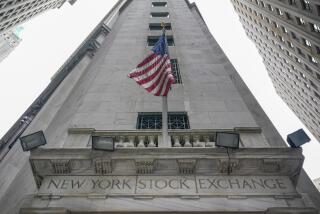A new sign that we’re in a market bubble -- and could be heading for a bust

Want the Lamborghini? Sell your stocks, don’t borrow against them.
- Share via
This may seem to be an odd thing to worry about when the stock market is faltering (the Dow Jones Industrial Average is down more than 250 points on the day as I write), but evidence has been mounting for months that an economic bubble is building in the U.S.
That’s not a happy prospect. In the financial markets, bubbles never go away quietly.
The most disquieting indication is a ferocious run-up in borrowings against stock and bond holdings. We’re not talking about margin loans, which are used to buy securities and are limited to 50% of the value of one’s stock and bond holdings.
The real increase has been in “non-purpose” or securities-based loans, which are used for other needs or, well, for fun — a second house, a boat, a vacation, etc. They’re collateralized by the same securities but can amount to as much as 95% of a portfolio.
At a press briefing last week reported by Business Insider, Mike Wilson, an executive of Morgan Stanley’s wealth management arm, cautioned that “Consumers are feeling pretty good, and they are starting to spend money again, and they’re starting to do dumb things. They’re starting to borrow money, they’re starting to maybe buy that house they shouldn’t or that car they shouldn’t.”
See the most-read stories this hour >>
That’s amusing, because Morgan Stanley has been aggressively hawking non-purpose loans: its total securities-based loans totaled $38 billion at the end of 2014, a 70% increase over two years earlier according to an analysis by Paul Meyer of the Securities Litigation and Consulting Group.
The firm’s pitch to clients is entitled “Invest in Your Dreams.” Among those dreams it puts in its clients’ heads: “The restaurant you’ve always wanted to open. That advanced degree you finally have time for. The perfect house that won’t be on the market long. A 1963 Ferrari GTO, just because.”
Some of those are certainly going to be “dumb things,” in Wilson’s words. Adds Josh Brown of Ritholtz Wealth Management and The Reformed Broker website: “Consumers really are doing dumb things. And they have plenty of help.”
Meyer observes that securities-based lending is especially risky — for the borrower. (For the broker, it’s great.) This lending “creates serious conflicts of interest, saddling the customer with risks and potential long-term consequences he or she may not fully understand until the next bear market arrives.”
SIGN UP for the free California Inc. business newsletter >>
Borrowers typically aren’t judged by their ability to repay — their credit rating, income, or expenses — but chiefly by the size of their portfolio. As the Morgan Stanley spiel shows, customers are encouraged to borrow for the purpose of consuming, rather than investing. Brokers are incentivized to put clients in these loans through higher commissions and cash bonuses.
It’s one thing to buy securities on margin; the strategy isn’t risk-free but the margin loans have a cushion of 50% of the value of the underlying security, which limits the risk except in a severe downturn. Non-purpose borrowing against a portfolio can have a smaller cushion, and in the case of a downturn that prompts brokers to call in the loan, the money is gone — spent on that restaurant, house, GTO or vacation.
The prudent way to use securities to fund such dreams, of course, is to sell them and spend the proceeds. Borrowing against them instead could magnify the pain of a downturn for customers, and for the markets. Excessive leverage, remember, is what really drove the housing crash a few years ago — homeowners had borrowed against their equity and spent the money, leaving no refuge when home prices began to turn down.
The rapid growth in securities loans prompted the Financial Industry Regulatory Authority, the industry self-regulatory arm known as Finra, to put the practice on watch earlier this year. “Any time you see leverage increase in a variety of ways,” Finra Chief Executive Richard Ketchum said, “that increases risk for investors.”
But so far, Finra hasn’t taken action to rein in the lending. As Meyer observes, the size of the portfolios in brokerage accounts may create an irresistible temptation for brokers with clients looking to fund their “dreams.” With $16 trillion in client holdings sitting in accounts at brokerage houses, Meyer writes, “there is still a lot of potential collateral waiting to be encumbered.”
And a lot of downside.
Keep up to date with the Economy Hub. Follow @hiltzikm on Twitter, see our Facebook page, or email [email protected].
Hoy: Léa esta historia en español
MORE FROM MICHAEL HILTZIK:
Longtime teachers’ pensions are well earned
Why Big Pharma’s patient-assistance programs are a sham
Fiorina, pressed on Planned Parenthood, becomes even more extreme
More to Read
Inside the business of entertainment
The Wide Shot brings you news, analysis and insights on everything from streaming wars to production — and what it all means for the future.
You may occasionally receive promotional content from the Los Angeles Times.











